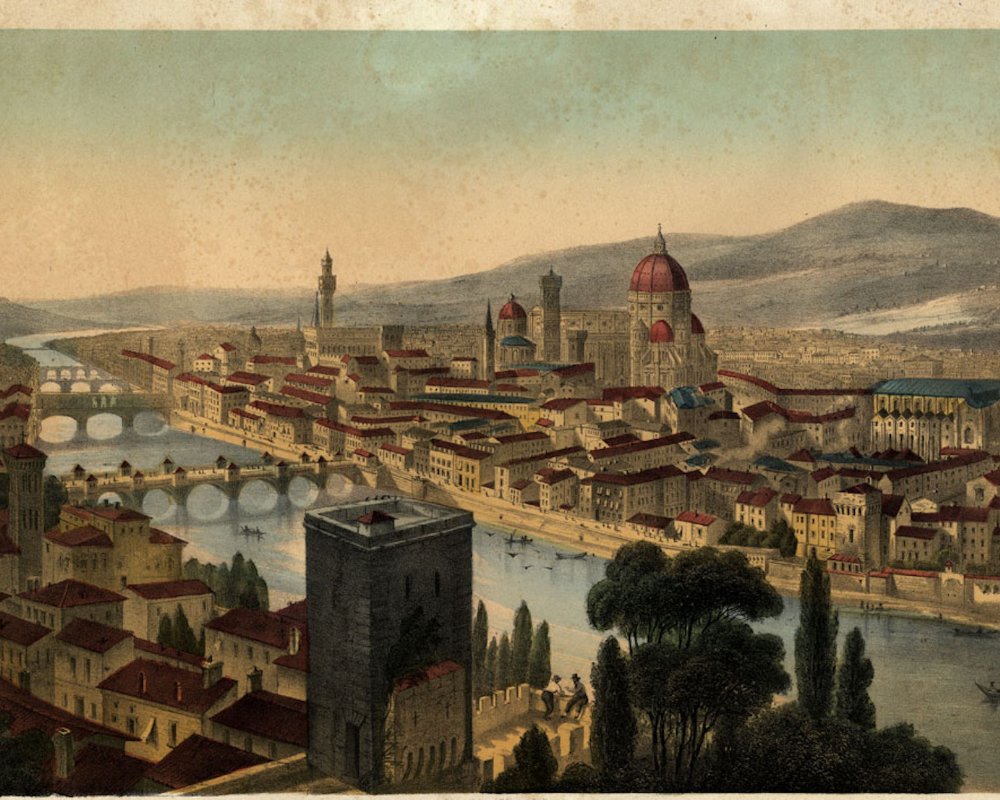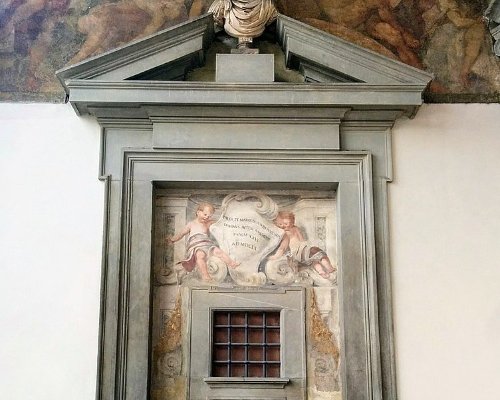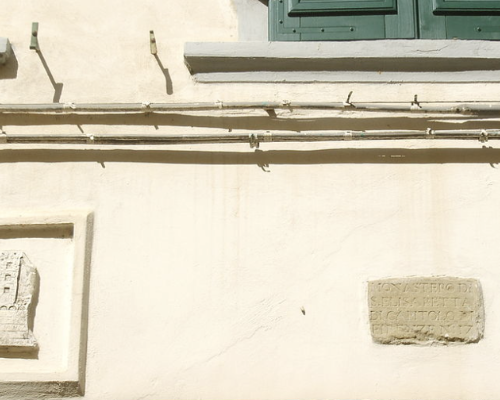The city through the stories of the women who inhabited and livened it up
Nobles or commoners.
Saints or "sinners."
Admired or hidden.
We remember the women who intertwined their small and great stories with that of Florence, following an itinerary that reveals the traces they left in the names of the streets, in the plaques of the palaces, in the soul of the city.
The itinerary begins in Piazza Santissima Annunziata, defended by the church of the same name and characterized by the two long porticoes facing each other: the one belonging to the Confraternita dei Servi di Maria and that of the Spedale degli Innocenti, a neo-Renaissance work by Filippo Brunelleschi.
Founded in the first half of the 1400s, the Spedale was Europe's first orphanage, a place designed to take in abandoned babies. Initially the babies were left in the pila, a stoup placed outside the loggia; later an iron window was added and the pila was replaced with the so-called Rota degli Esposti, which allowed the baby to be left without being recognized from the inside.
The first child to be taken in was Agata, on 5 February 1445: "They called me Agata because that was St. Agatha's night, and Smeralda because of my eyes which, even though I did not live long, continued to shine in the gaze of all the children who crossed this threshold after me." You can read the rest of the story here.
Between 1600 and 1700 the Institute began to welcome unmarried mothers among the in-house wet-nurses, that is, those responsible for providing the first care to newborns, thus initiating a welfare practice for women, as well.
Today the building houses the Museo e Istituto degli Innocenti, as well as being the national Center for documentation and analysis on childhood and adolescence, a reference point for the promotion of the care of children's rights.
The itinerary begins in Piazza Santissima Annunziata, defended by the church of the same name and characterized by the two long porticoes facing each other: the one belonging to the Confraternita dei Servi di Maria and that of the Spedale degli Innocenti, a neo-Renaissance work by Filippo Brunelleschi.
Founded in the first half of the 1400s, the Spedale was Europe's first orphanage, a place designed to take in abandoned babies. Initially the babies were left in the pila, a stoup placed outside the loggia; later an iron window was added and the pila was replaced with the so-called Rota degli Esposti, which allowed the baby to be left without being recognized from the inside.
The first child to be taken in was Agata, on 5 February 1445: "They called me Agata because that was St. Agatha's night, and Smeralda because of my eyes which, even though I did not live long, continued to shine in the gaze of all the children who crossed this threshold after me." You can read the rest of the story here.
Between 1600 and 1700 the Institute began to welcome unmarried mothers among the in-house wet-nurses, that is, those responsible for providing the first care to newborns, thus initiating a welfare practice for women, as well.
Today the building houses the Museo e Istituto degli Innocenti, as well as being the national Center for documentation and analysis on childhood and adolescence, a reference point for the promotion of the care of children's rights.
Piazza San Pier Maggiore once housed the church of the same name and, attached to it, one of the oldest monasteries in Florence, whose presence and distinctiveness is remembered today in the name of the street, via delle Badesse. In fact, the abbess of this Benedictine monastery had an important and singular institutional task: to welcome the new bishop upon his arrival in the city and to receive from him a ring, in a ritual wedding, a symbol of the union between the new bishop and the Florentine Church. For this reason, in typical local irony, the abbess was nicknamed "the bishop's bride."
The Church of San Piero Maggiore was demolished in 1783-1784 and the monastery was, at the same time, secularized as part of the grand duke's plan to reduce the presence of religious institutions in the city as much as possible.
Piazza San Pier Maggiore once housed the church of the same name and, attached to it, one of the oldest monasteries in Florence, whose presence and distinctiveness is remembered today in the name of the street, via delle Badesse. In fact, the abbess of this Benedictine monastery had an important and singular institutional task: to welcome the new bishop upon his arrival in the city and to receive from him a ring, in a ritual wedding, a symbol of the union between the new bishop and the Florentine Church. For this reason, in typical local irony, the abbess was nicknamed "the bishop's bride."
The Church of San Piero Maggiore was demolished in 1783-1784 and the monastery was, at the same time, secularized as part of the grand duke's plan to reduce the presence of religious institutions in the city as much as possible.
A plaque and a coat of arms placed at the same height as numbers 18 and 12 red in via San Giuseppe, behind Piazza Santa Croce, remind us that here, in the 14th century, stood the Convent of the pinzochere of Santa Elisabetta in Capitolo, a Monastery of spinsters who led a monastic life without having taken their vows: women who decided to change their lives by devoting themselves to religion, women without financial support from their husbands, spinsters, widows.
The pinzochere were thus called because of their dress made of a coarse fabric in bigio (dull gray) or bizzo, from which derived the nickname bizzochere, later changed to pinzochere.
They were entrusted with the care of the basilica of Santa Croce, which they accessed through a side door, now walled up, called precisely Porta delle Pinzochere, an almost hidden access that gave rise to rumors and gossip.
The monastery was suppressed in the 19th century.
To the memory of these women is dedicated the nearby via delle Pinzochere.
A plaque and a coat of arms placed at the same height as numbers 18 and 12 red in via San Giuseppe, behind Piazza Santa Croce, remind us that here, in the 14th century, stood the Convent of the pinzochere of Santa Elisabetta in Capitolo, a Monastery of spinsters who led a monastic life without having taken their vows: women who decided to change their lives by devoting themselves to religion, women without financial support from their husbands, spinsters, widows.
The pinzochere were thus called because of their dress made of a coarse fabric in bigio (dull gray) or bizzo, from which derived the nickname bizzochere, later changed to pinzochere.
They were entrusted with the care of the basilica of Santa Croce, which they accessed through a side door, now walled up, called precisely Porta delle Pinzochere, an almost hidden access that gave rise to rumors and gossip.
The monastery was suppressed in the 19th century.
To the memory of these women is dedicated the nearby via delle Pinzochere.
Staying in the Santa Croce district, we cross via Parlagio (or Parlascio), where a small plaque recalls the ancient and curious name of this street: via delle Serve Smarrite. The most probable version traces the origin of the term to the presence here of a sort of meeting place for "lost" (smarrite) women who had arrived in the city from the countryside, looking for work with wealthy Florentine families, as, indeed, "servants" (serve).
Staying in the Santa Croce district, we cross via Parlagio (or Parlascio), where a small plaque recalls the ancient and curious name of this street: via delle Serve Smarrite. The most probable version traces the origin of the term to the presence here of a sort of meeting place for "lost" (smarrite) women who had arrived in the city from the countryside, looking for work with wealthy Florentine families, as, indeed, "servants" (serve).
Born in 1667, the only daughter of Grand Duke Cosimo III and of princess Margherita Luisa d'Orléans, Anna Maria Luisa de' Medici was the last representative of the Grand-Ducal branch of the Medici.
Following the death of her husband Giovani Carlo Guglielmo (John Charles William) I, Prince-Elector of the Palatinate (hence the name Elettrice Palatina), Anna Maria Luisa returned to Florence and remained there until her death in 1743 at the Pitti Palace.
She is credited with transferring into public hands the artistic heritage of the family that had dominated Florence and beyond for centuries: by a legal act, known as the "Family Pact", Anna Maria Luisa left all the Medici collections to the state.
The Elettrice Palatina is remembered and celebrated every February 18, the anniversary of her death, with events and cultural initiatives.
Born in 1667, the only daughter of Grand Duke Cosimo III and of princess Margherita Luisa d'Orléans, Anna Maria Luisa de' Medici was the last representative of the Grand-Ducal branch of the Medici.
Following the death of her husband Giovani Carlo Guglielmo (John Charles William) I, Prince-Elector of the Palatinate (hence the name Elettrice Palatina), Anna Maria Luisa returned to Florence and remained there until her death in 1743 at the Pitti Palace.
She is credited with transferring into public hands the artistic heritage of the family that had dominated Florence and beyond for centuries: by a legal act, known as the "Family Pact", Anna Maria Luisa left all the Medici collections to the state.
The Elettrice Palatina is remembered and celebrated every February 18, the anniversary of her death, with events and cultural initiatives.
The historic and noble Palazzo Portinai-Salvati is located on via del Corso, at the corner with via
dello Studio. If the name does not sound new, it is because this was the home of Beatrice Portinai, the Beatrice who, according to tradition, was Dante's inspirational muse. A plaque commemorates their first meeting, in the words of the poet himself.
The historic and noble Palazzo Portinai-Salvati is located on via del Corso, at the corner with via
dello Studio. If the name does not sound new, it is because this was the home of Beatrice Portinai, the Beatrice who, according to tradition, was Dante's inspirational muse. A plaque commemorates their first meeting, in the words of the poet himself.
Polissena de’ Nelli, later known as Plautilla, entered the convent of Santa Caterina at the age of 14 and
here, as a self-taught artist, practiced the art of painting: without ever taking drawing lessons, without
ever serving as an apprentice in one of the workshops of the time, but only by copying other works
and using her fellow sisters as models, Plautilla succeeded in producing grand and highly-appreciated
works.
She is considered the first Florentine woman painter whose works are preserved (there are three still extant
and attributed with certainty). Her Last Supper is a painting 7 meters long and 2 meters high, with life-
size painted characters; an extraordinary work, now restored and housed in the Museum of Santa
Maria Novella.
Plautilla Nelli died in her convent in 1588.
Polissena de’ Nelli, later known as Plautilla, entered the convent of Santa Caterina at the age of 14 and
here, as a self-taught artist, practiced the art of painting: without ever taking drawing lessons, without
ever serving as an apprentice in one of the workshops of the time, but only by copying other works
and using her fellow sisters as models, Plautilla succeeded in producing grand and highly-appreciated
works.
She is considered the first Florentine woman painter whose works are preserved (there are three still extant
and attributed with certainty). Her Last Supper is a painting 7 meters long and 2 meters high, with life-
size painted characters; an extraordinary work, now restored and housed in the Museum of Santa
Maria Novella.
Plautilla Nelli died in her convent in 1588.


